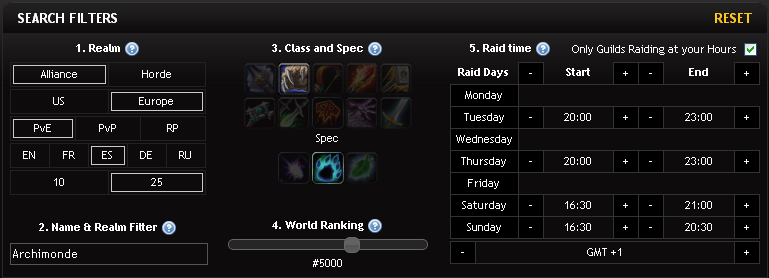In World of Raids Guild Recruitment Tool, we wanted the search to be instant! We achieved this goal by not having a single page refresh or ajax call while updating the settings. Since it runs in the browser, performance was a real concern. We will see in this article what were the tricks used to make this real.
Sorting
In order to sort the guilds, each guild is given a matching score (between 0 and 65535) based on the current filters. At start, each guild has the maximum points. Then, each filter is giving a malus. For example when a specialization doesn't match, the guild loses 10%.
This means that everytime you change a filter, you have to recompute that matching score for all the guilds. Instead of recomputing the whole matching score, the guild holds the result of each filter. Everytime a filter is updated, the value of this filter is upated on every guild. The global matching score is now recalculated by summing all the partial precomputed scores.
Every bit of code in the matching function has been optimized, no more jquery code, loops are unrolled and great use of lazy boolean expression evaluation. The sort function itself also got boosted thanks to a trick I commented on my previous article Speed Up Javascript Sort().
Display
Once we have the data sorted, it has to be displayed! And this is another big time eater. When it takes 50ms to sort the data, it takes about 150ms to display 10 guilds!
Since we wanted performances, DOM elements are created at page loading, they are then only being updated as the guilds change. And still, only the required changes are made, for example tooltips are created as the user trigger the mouseover event.
The main problem with this is that we are not able to make bulk changes. Everytime you make the slightest change, the whole UI has to be redrawn which is a waste of time. I hope there will be such API in the future.
Since it's a web application, we had to maintain the url up to date, this is done using SmallHash, a small library of mine that compresses filter data into the smallest possible hash.
Scaling
Having all the data being sent at page loading is a pain, it makes it load slowly. One way to avoid this problem would be to use the localstorage to keep these data accross sessions and only send the updated guilds. However at the time I started developping the application there was no released browser supporting HTML5.
However, the application is focused on World of Warcraft guilds. This is a limited audience and there is no need on heavy scaling there. So we decided that it was a good option to go.
Up to 3000 guilds, this is pretty much instant in every browser in my MacBook Pro. When increasing that number to 10 000 it is taking more than a second to update on IE8. It requires 50 000 guilds for Chrome 3 to get slow, which is a pretty good score. It means that it is possible to do heavy processing, the bandwith now being the limiting factor.

